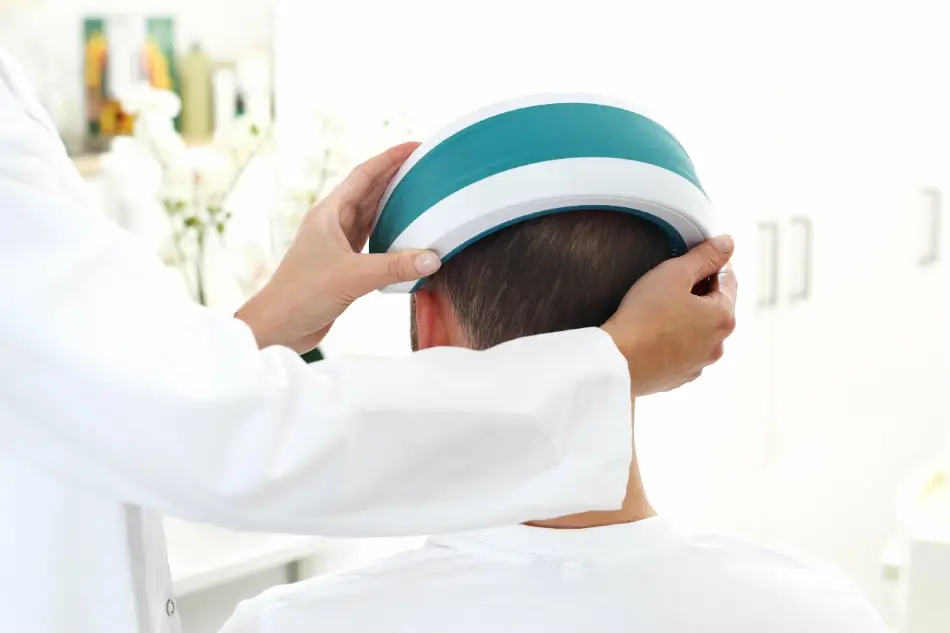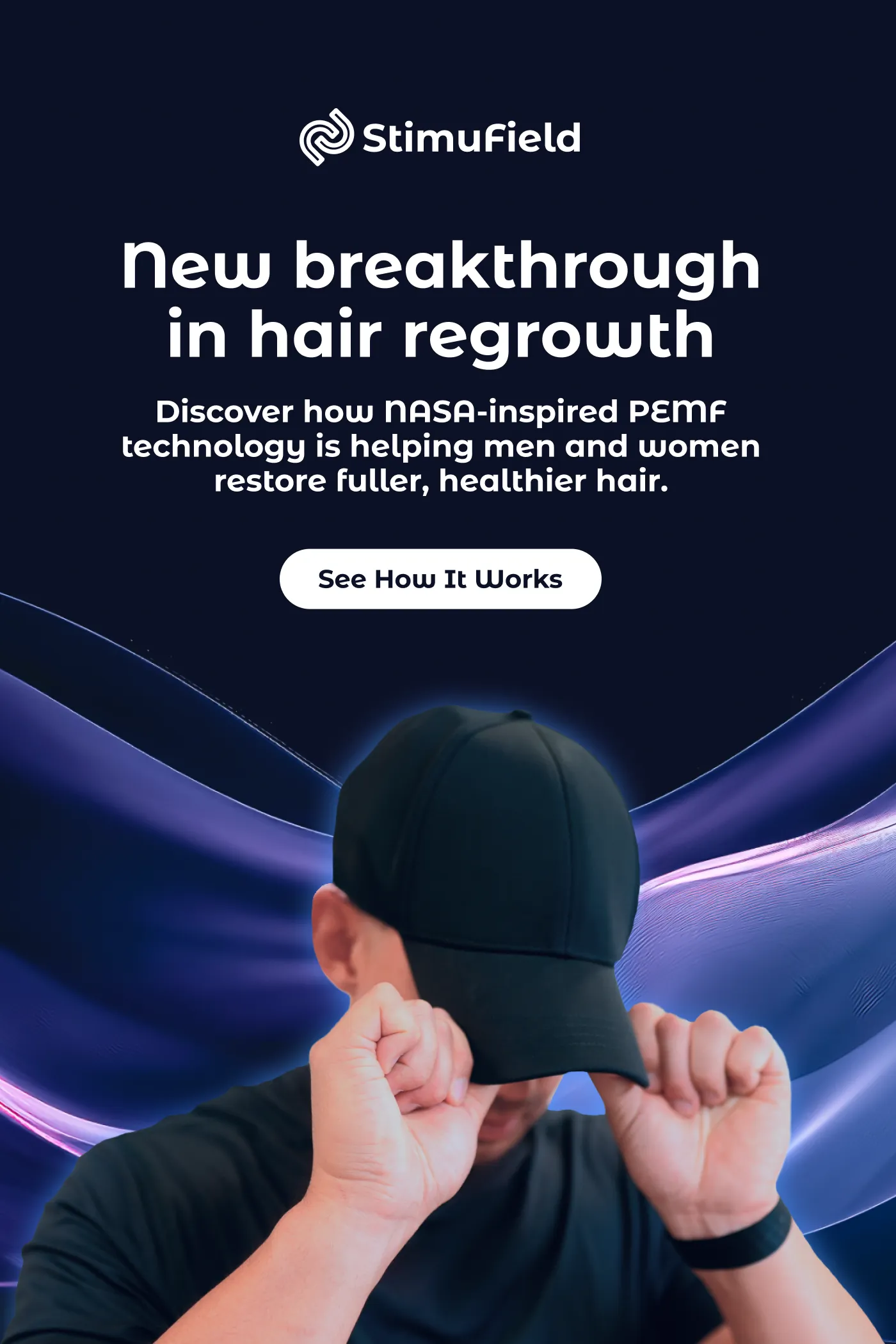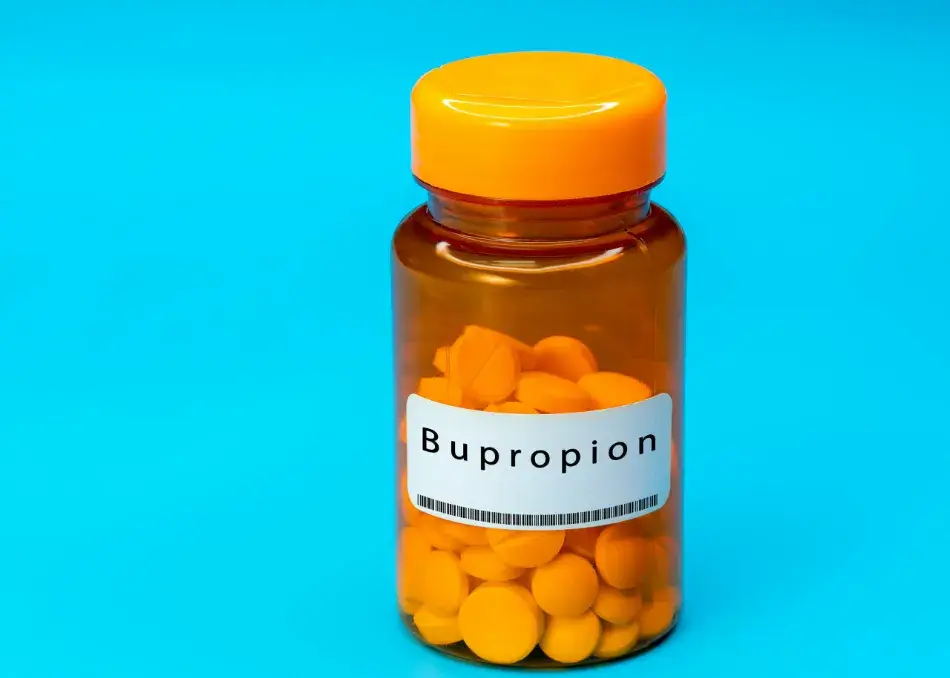Hair loss is a common chronic health issue affecting both males and females. Pattern hair loss, also known as androgenic alopecia, is the most common form. It affects over 50% of men and women during their lifespan. (1,2)
There are two categories of non-invasive medical devices to treat hair loss: the original Low-Level Laser Therapy (LLLT) caps and new Pulsed Electromagnetic Field (PEMF) therapy caps, which are growing in popularity.
LLLT for hair growth uses light stimulation to encourage tissue repair and regeneration, including hair regrowth. It’s also known as low-level light therapy, red light therapy, red laser therapy, or photobiomodulation. (3) PEMF uses electromagnetic fields to promote healing and hair growth. (3) It’s sometimes called Low Field Magnetic Stimulation (LFMS).
Both LLLT and PEMF have shown promising results in treating hair loss. (2) When it comes to hair loss treatment comparisons, LLLT is more well-researched but more expensive. On the other hand, PEMF has a growing body of research and is generally more affordable and convenient. (3) We’ll compare both options in more detail in this article.
What is the Difference Between LLLT (aka Red Light Therapy) and PEMF?
Red light therapy and PEMF are both non-invasive treatments that can be used to tackle hair loss. Both treatments use similar devices, such as hats and domes, to focus the treatment on the scalp. Treatment can be performed at home or in a clinical setting. Similarly, both treatments have a low risk of side effects. (2)
However, red light therapy and PEMF have different mechanisms of action, which means they work differently. LLLT or red light therapy works by targeting the scalp with low-energy light waves, while PEMF uses low-frequency electromagnetic fields. (2,3) LLLT for hair loss has been on the market for longer and is FDA approved, while PEMF is a newer treatment with less supportive data. (2)
What Is LLLT (Low-Level Laser Therapy)?
Low-level laser therapy (LLLT) is a type of photobiomodulation, meaning it uses red and near-infrared light waves to help with healing and encourage cell repair. (1) The most common LLLT devices use light waves in the 630-660 nm (red light) range delivered to the scalp using optic fibres or LEDs to promote hair growth. (3,4,14)
Red light therapy is thought to stimulate the stem cells that cause hair growth. (2,3) It also extends the anagen phase, which is the growth phase of the hair growth cycle. (3)
Several studies have shown positive outcomes for the use of LLLT in patients with alopecia areata, androgenic alopecia, and chemotherapy-induced alopecia. (3) The results included reduced hair loss, improved hair growth, increased hair density, and stronger hair strands with very minimal side effects. (2) Research suggests that the closer the device is to the scalp, the better the effect. (3)
One study over 26 weeks using the HairMax LaserComb® versus a sham treatment found that patients using the real comb experienced a significant increase in hair growth. (1) Another study using a hat-style laser device on male patients every other day for 16 weeks reported a 35 percent increase in hair growth. (5)
Low-level laser therapy for hair loss can be administered via a comb, a helmet, a hood, a hat, or a domed device. (3) These tend to be quite rigid devices, which can impact practicality and comfort levels. (3) Over 80 LLLT devices have been FDA-approved, which are largely similar combs or helmet devices. (2) The devices have proven to be similar in terms of effectiveness, although the helmets have slightly better outcomes. (2)
LLLT can be administered at home or in a clinic for between 8 and 30 minutes at each session. Sessions can be carried out daily or two to three times a week. (2) Interestingly, research has shown better results with less regular treatments. One study reported the largest increase of hair growth at 25.7 hairs per cm2, with a treatment time of 8 minutes three times a week. (2)
Studies suggest it can take between 3 and 9 months to see optimal results in a patient’s hair. (2) Like many hair loss treatments, LLLT may need to be continued long term to maintain hair growth.
What Is PEMF (Pulsed Electromagnetic Field Therapy)?
Pulsed Electromagnetic Field (PEMF) therapy is a type of electromagnetic stimulation which means it uses low-frequency electromagnetic fields to promote healing in the body. (3,6) During PEMF for hair growth, these magnetic fields are directed at the scalp. Studies have shown positive results in treating androgenic alopecia and chemotherapy-induced alopecia, among other types of hair loss. (3,6)
Electromagnetic fields work by opening cellular channels, helping calcium ions move in and out of the body’s cells. This can partially reverse cellular aging, helping cells to do their jobs more effectively and promoting cell regeneration. It directly stimulates the cells that are involved in hair growth and restoration, specifically the dermal papilla cells in the hair follicles. (2,3,6) Research also suggests PEMF can reduce stressors and inflammation, as well as indirectly help to balance hormones that affect the hair growth cycle. This can result in a longer hair growth cycle, leading to thicker, healthier hair and less hair loss. (2)
While PEMF has been used medically for decades, specific research on its use for hair regrowth is more recent and still limited. Current research shows promising outcomes, with a study on an early PEMF device showing an increase in hair growth of over 66% after 36 weeks of treatment compared to only a 25.6 percent increase in the control group. (7) Another study found that electromagnetic fields significantly enhanced hair follicle regrowth. (9)
PEMF also shows promise when used alongside other hair loss treatments. One study focused on the use of essential plant oils with PEMF and found an increase of 34 total hairs per cm2 compared to 9 hairs per cm2 in the control group. (2,8)
Electromagnetic stimulation has been approved by the FDA for the treatment of bone fractures, muscle stimulation, some mental health issues, and urinary incontinence. However, it has not yet been approved as a treatment for hair loss. Despite this, research suggests that it is a safe, effective treatment with few side effects. It’s often used off-label to treat hair loss conditions. (3,6)
PEMF for hair growth is administered in a very similar way to LLLT. (3) It’s often given through helmet or hat devices, which look very similar to LLLT devices, such as the StimuField cap device. However, they can be more portable, flexible, and comfortable.
One of the main limitations of LLLT is that the light used only has a superficial action. This means the light waves can be blocked by hair. PEMF overcomes this by providing a more uniform electromagnetic field that’s more likely to reach the roots of the hair. (2,3) Despite positive results, the data on PEMF as a treatment for androgenetic alopecia is still limited. To date, fewer than half a dozen papers have been published studying PEMF as a hair loss treatment. An established mechanism of action, defined parameters, recommended treatment regimens, and longitudinal data are lacking.
PEMF is often administered at a 50 Hz electromagnetic frequency, which is much lower than harmful frequencies. (3,6) However, usage time and frequencies vary. In a clinical setting, patients may receive treatment once or twice a week for up to 30 minutes. At home devices may be used more frequently, for example, for between 10 to 30 minutes each day. (3)
The timing of visible improvements can vary depending on the patient and their hair growth cycle, among other factors. Patients can generally expect visible results within three to six months, with potential continued progress from nine months onwards. (2)
LLLT vs PEMF: Side-by-Side Comparison
Both LLLT and PEMF are effective hair loss treatments, although how they work is different. (2) Like all medical treatments, they have pros and cons. The table below is a simple summary of laser vs electromagnetic therapy for hair loss.
| Feature | LLLT | PEMF |
| Mechanism | Red light waves | Electromagnetic stimulation |
| FDA Approval | Yes (many devices) (2) | Not approved for hair loss at this time. |
| Safety/ Side Effects | Well tolerated. May cause mild irritation or tingling in rare cases | Well tolerated thus far, studies ongoing. |
| Ease of use | Typically rigid caps or caps/combs | Often soft, flexible caps or wearable mats |
| Evidence | Stronger clinical base | Growing, still emerging |
| Cost | $500-2,000 (higher cost due to expensive lasers) | $400-1,200 |
| Time | 8-30 min/day (2) | Home devices: 10-30 min/day (3) |
| Comfort & Sensation | Slight warmth or tingling | Well tolerated at lower levels. |
| Battery Efficiency | Higher power consumption | Low energy consumption, longer battery life |
| Device Durability | May degrade with heat or light exposure over time | Generally more durable |
Which Therapy Is More Effective for Hair Growth?
Research shows that both LLLT and PEMF are effective at treating hair loss. Studies on LLLT show patients experienced significant improvements in hair strength, hair density, and hair regrowth. (1,2) Although there have been fewer studies on PEMF, preliminary studies show notable increases in hair growth and improvements in hair thickness and length. (2)
In regard to the question: “Is LLLT or PEMF better for hair regrowth?”, it depends on the individual’s needs. PEMF appears to be effective, but it is not yet FDA-approved to treat hair loss. It can be more affordable and allows for more convenient wearable devices. LLLT is FDA approved and has a longer track record, but is more expensive. (2)
For patients with early-stage hair loss or for women who still have a relatively thick or dark head of hair, PEMF may be the best choice. Research shows the lasers used in LLLT aren’t as effective on longer, thicker, or darker hair as they struggle to penetrate through to the scalp. This is particularly true of cap or helmet devices. (2,3)
Studies on Fitzpatrick skin types I–IV, meaning white to light brown skin, have shown that LLLT and PEMF are both safe and effective in treating hair loss. Unfortunately, there has been little to no research done on the effect of LLLT or PEMF on dark skin tones, specifically Fitzpatrick skin types V-VI. Some research suggests that melanin may cause increased absorption of light therapy, which could potentially increase side effects such as burning of the skin and scalp. More research is needed in this area. (2,10)
For patients with skin sensitivity, PEMF may be a good option, as it has little to no side effects. On the other hand, LLLT can cause mild adverse effects, including itching and scalp sensitivity. (2,3)
For patients who have recently had a hair transplant, either LLLT or PEMF may help reduce inflammation, promote quicker healing, and encourage hair growth. (2,11)
Combination therapies (e.g., oral medications or micro needling) are often done when PEMF is used.
Potential Side Effects and Considerations of LLLT and PEMF
Despite being non-invasive hair regrowth treatments, PEMF and LLLT do still have some potential side effects and things to keep in mind. LLLT can cause some very mild adverse effects, including scalp sensitivity, itching, or irritation. However, it’s generally a safe treatment, and side effects typically resolve within two weeks. (1,2,3,4)
PEMF may have similar mild side effects on the scalp, but so far, no specific side effects have been found for the use of PEMF as a stand-alone therapy. When PEMF is used in conjunction with other scalp stimulation therapy methods, mild adverse effects such as scalp irritation have been noted. (2)
Since PEMF uses electromagnetic fields, it’s not advised for people with implanted metal devices such as pacemakers or cochlear implants. (12) Pregnant people should consult with their doctors before trying LLLT or PEMF, as there is limited research on their effects during pregnancy. (1,12)
When searching for a quality LLLT device, always make sure you choose one that is FDA-approved and ideally uses light waves in a range of 630–670 nanometers. It should be easy to use and suit your needs. (13)
Similarly, PEMF devices should be high quality, bought from a reputable seller, and easy to wear. It’s best to consult a professional for guidance if you’re unsure.
Can LLLT and PEMF Be Combined for Hair Growth?
Both LLLT and PEMF are highly effective therapies for hair growth. When they’re combined, research suggests they are even more effective. (2,3) Although their mechanisms of action are different, their benefits and results on the hair follicles are similar. This means they can complement each other well as part of hair regrowth combo therapies. (2,3)
One study combined LLLT and PEMF over 24 weeks to treat androgenic alopecia in both males and females. The results showed an increase in hair density of 23.93% in the treatment group compared to only 6.15% in the control group. (3)
Takeaway: Which One Should You Choose?
Preliminary research shows that PEMF delivers solid results with convenient and discreet wearable devices. It’s also significantly less expensive than LLLT. However, there’s less research in this modality, and it lacks FDA approval for hair loss. LLLT has been around for many years and has proven, predictable results, but is more expensive and typically involves bulkier devices. Combined treatments may further enhance hair growth, although may be more costly. (2,3)
Both appear to be safe, effective treatments with minor side effects. Consider your needs, comfort, and your budget when making your choice. Check in with your dermatologist to get advice on which treatment is best for you.








